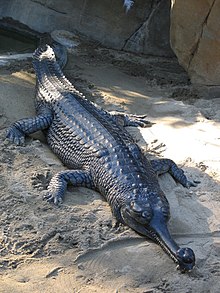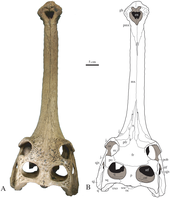Gavialis
| Gavialis Temporal range: Early Miocene - recent, | |
|---|---|

| |
| The gharial (Gavialis gangeticus), the only living species of Gavialis | |
| Scientific classification | |
| Domain: | Eukaryota |
| Kingdom: | Animalia |
| Phylum: | Chordata |
| Class: | Reptilia |
| Clade: | Archosauromorpha |
| Clade: | Archosauriformes |
| Order: | Crocodilia |
| Family: | Gavialidae |
| Subfamily: | Gavialinae |
| Genus: | Gavialis Oppel, 1811 |
| Species | |

Gavialis is a genus of crocodylians that includes the living gharial Gavialis gangeticus and one known extinct species, Gavialis bengawanicus.[1] G. gangeticus comes from the Indian Subcontinent,[2] while G. bengawanicus is known from Java. Gavialis likely first appeared in the Indian Subcontinent in the Pliocene and dispersed into the Malay Archipelago through a path called the Siva–Malayan route in the Quaternary. Remains attributed to Gavialis have also been found on Sulawesi and Woodlark Island east of the Wallace Line, suggesting a prehistoric lineage of Gavialis was able to traverse marine environments and reach places possibly as far as western Oceania.[3]
The genus Gavialis was reevaluated in 2018 based on specimens in the Natural History Museum, London that were collected in the Sivalik Hills. The author concluded that G. gangeticus and G. bengawanicus are the only two species in the genus Gavialis, with G. hysudricus as a junior synonym of G. gangeticus. Rhamphosuchus is proposed to include G. leptodus, G. pachyrhynchus, G. curvirostris and G. breviceps. The species G. browni and G. lewisi require further revisions.[1] G. dixoni has been assigned its own genus, Dollosuchus.[4]
The below cladogram of the major extant crocodile groups is based on the latest molecular studies, and shows the gharial's close relationship to the false gharial, and how the gavialids and crocodiles are more closely related than the alligatoroids:[5][6][7][8][9]
Here is a more detailed cladogram that shows Gavialis's proposed placement within Gavialidae, including extinct members:[8]
| Gavialidae |
| ||||||||||||
References
- ^ a b Martin, J. E. (2018). "The taxonomic content of the genus Gavialis from the Siwalik Hills of India and Pakistan" (PDF). Papers in Palaeontology. 5 (3): 483–497. doi:10.1002/spp2.1247. S2CID 134966832.
- ^ Lull, R. S. (1944). "Fossil gavials from north India". American Journal of Science. 242 (8): 417–430. Bibcode:1944AmJS..242..417L. doi:10.2475/ajs.242.8.417.
- ^ Delfino, M.; De Vos, J. (2010). "A revision of the Dubois crocodylians, Gavialis bengawanicus and Crocodylus ossifragus, from the Pleistocene Homo erectus beds of Java". Journal of Vertebrate Paleontology. 30 (2): 427. Bibcode:2010JVPal..30..427D. doi:10.1080/02724631003617910. S2CID 86396515.
- ^ Swinton, W. E. (1937). "The crocodile of Maransart (Dollosuchus dixoni [Owen])". Mémoires du Musée d'Histoire Naturelle de Belgique. 80: 1–44.
- ^ Harshman, J.; Huddleston, C. J.; Bollback, J. P.; Parsons, T. J.; Braun, M. J. (2003). "True and false gharials: A nuclear gene phylogeny of crocodylia" (PDF). Systematic Biology. 52 (3): 386–402. doi:10.1080/10635150309323. PMID 12775527. Archived from the original (PDF) on 2022-10-09. Retrieved 2021-06-28.
- ^ Gatesy, J.; Amato, G. (2008). "The rapid accumulation of consistent molecular support for intergeneric crocodylian relationships". Molecular Phylogenetics and Evolution. 48 (3): 1232–1237. doi:10.1016/j.ympev.2008.02.009. PMID 18372192.
- ^ Erickson, G. M.; Gignac, P. M.; Steppan, S. J.; Lappin, A. K.; Vliet, K. A.; Brueggen, J. A.; Inouye, B. D.; Kledzik, D. & Webb, G. J. W. (2012). "Insights into the ecology and evolutionary success of crocodilians revealed through bite-force and tooth-pressure experimentation". PLOS ONE. 7 (3): e31781. Bibcode:2012PLoSO...731781E. doi:10.1371/journal.pone.0031781. PMC 3303775. PMID 22431965.
- ^ a b Michael S. Y. Lee; Adam M. Yates (27 June 2018). "Tip-dating and homoplasy: reconciling the shallow molecular divergences of modern gharials with their long fossil". Proceedings of the Royal Society B. 285 (1881). doi:10.1098/rspb.2018.1071. PMC 6030529. PMID 30051855.
- ^ Hekkala, E.; Gatesy, J.; Narechania, A.; Meredith, R.; Russello, M.; Aardema, M. L.; Jensen, E.; Montanari, S.; Brochu, C.; Norell, M.; Amato, G. (2021-04-27). "Paleogenomics illuminates the evolutionary history of the extinct Holocene "horned" crocodile of Madagascar, Voay robustus". Communications Biology. 4 (1): 505. doi:10.1038/s42003-021-02017-0. ISSN 2399-3642. PMC 8079395. PMID 33907305.



